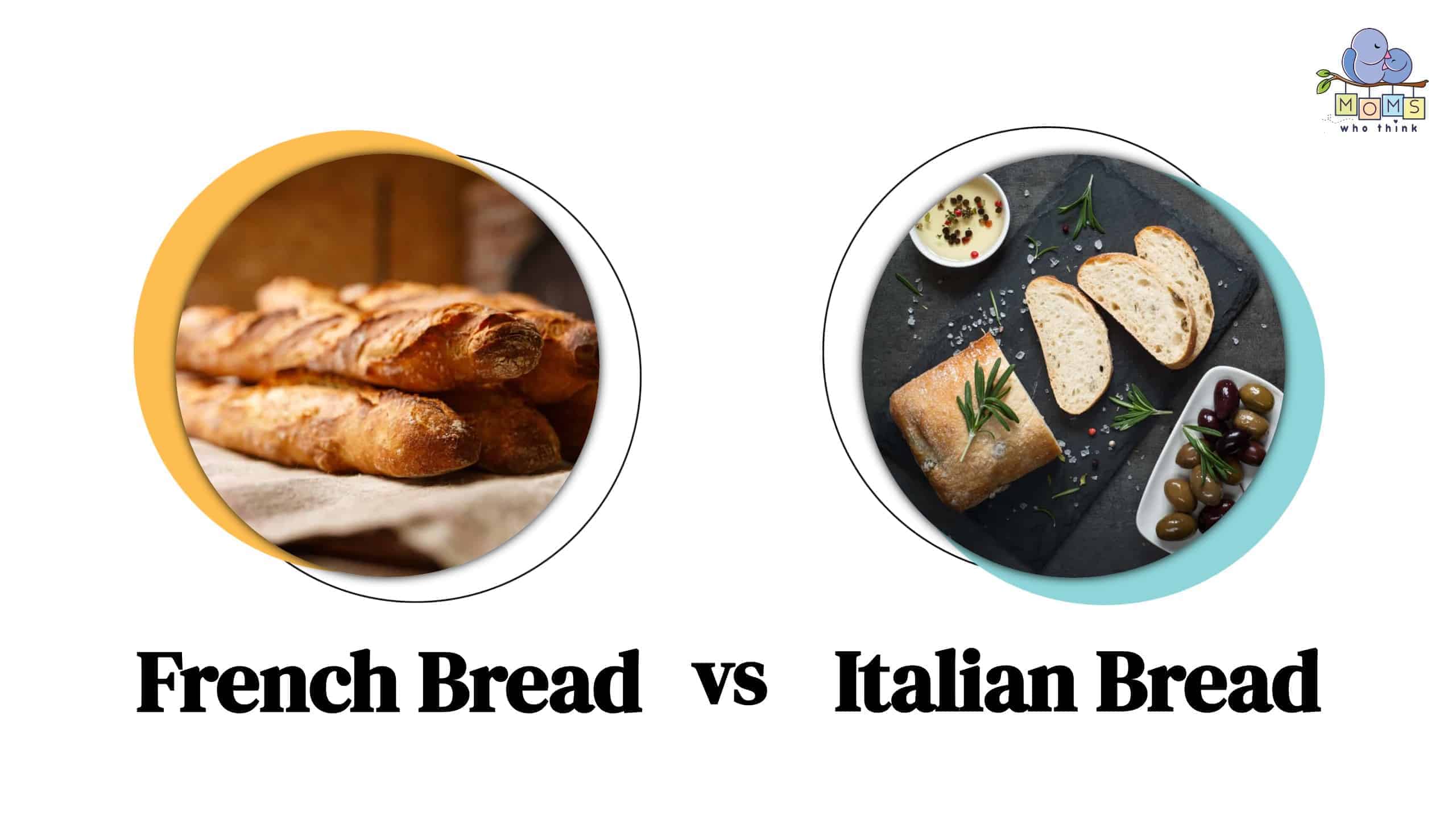Welcome, thinking moms, to a scrumptious exploration of two culinary wonders: French bread and Italian bread. We're here to shed some light on the distinct characteristics of these beloved breads, their nutritional profiles, whether they are interchangeable, and, if not, what other delectable options you have in their place.
Are French Bread and Italian Bread the Same Thing?
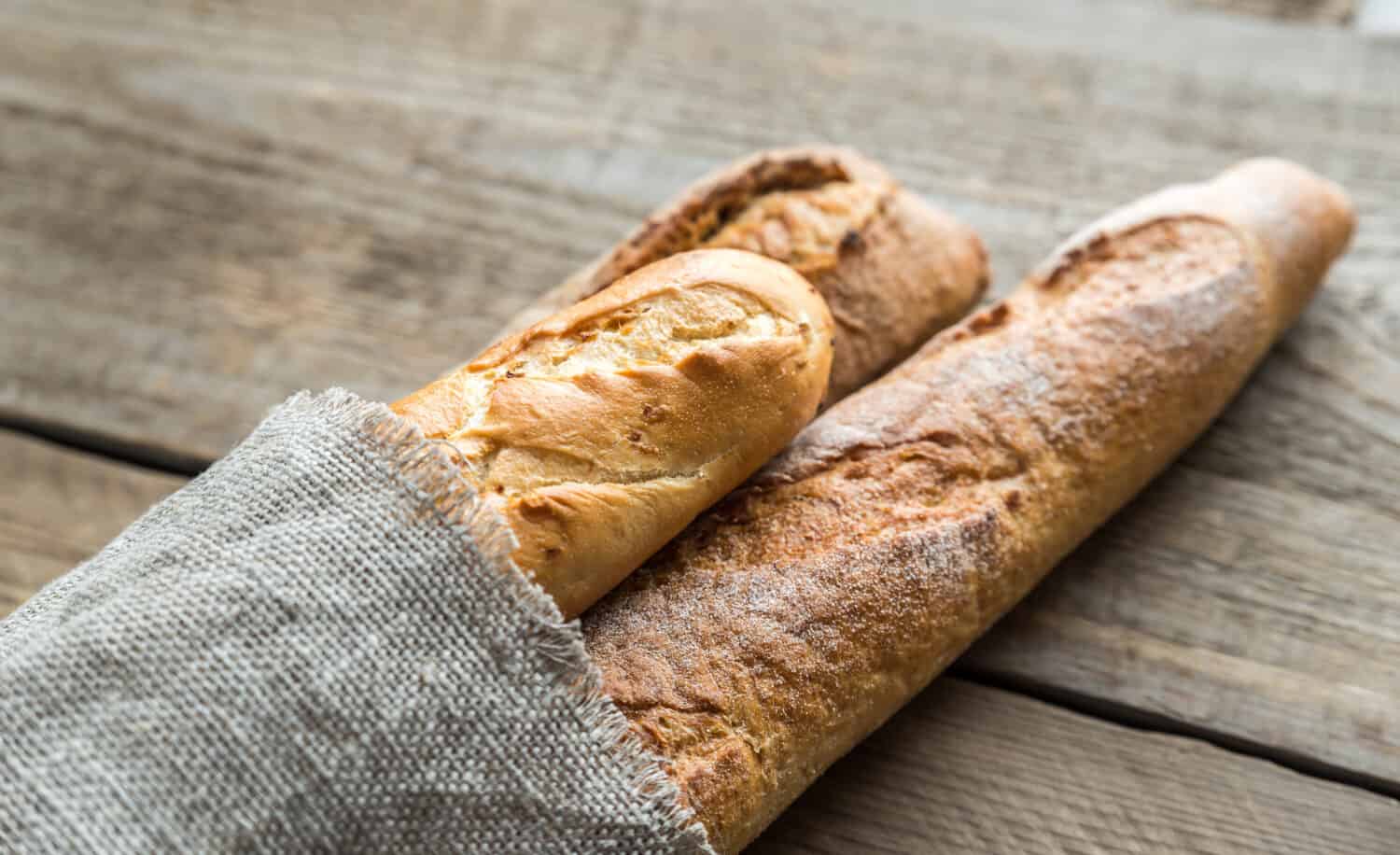
The Baguette is one of the most iconic types of French bread in contemporary bakeries.
©Alexander Prokopenko/Shutterstock.com
If you've found yourself at the supermarket bakery display, looking at two loaves of bread that you cannot tell apart, you're not alone. This is a common question; the short answer is no, they are not the same thing. What it comes down to is ingredients and fermentation techniques.
The most iconic French bread, often referred to as a “baguette,” is a staple in French cuisine and renowned for its long, slender shape with a crisp crust and soft interior. On the other hand, Italian bread comes in various shapes, from round loaves to braided beauties, and often features a thicker crust and denser texture.
Nutritional Differences Between French Bread and Italian Bread
When it comes to nutrition, both French bread and Italian bread have their own unique qualities. Let's take a closer look:
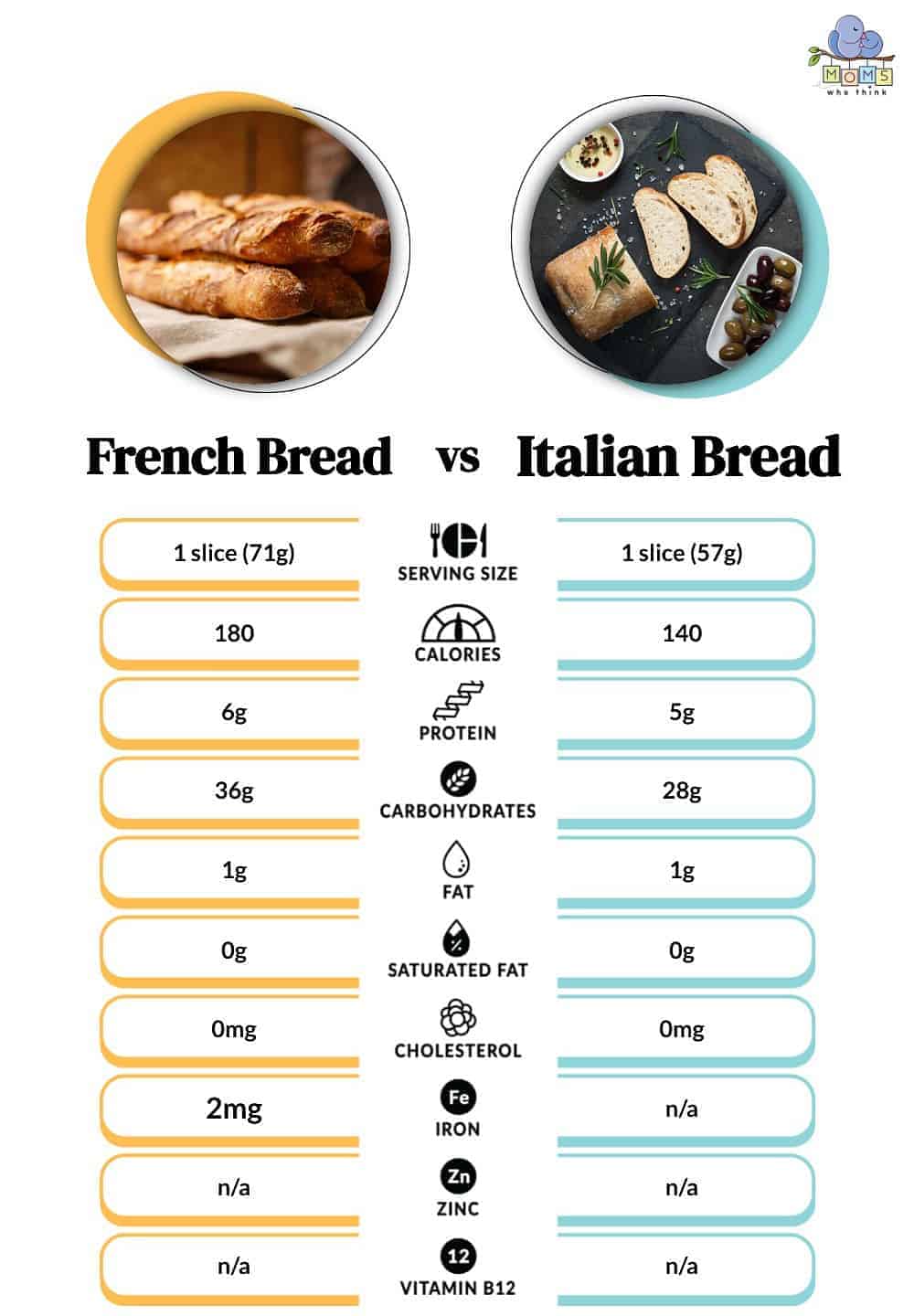
French Bread:
- You make French bread with flour, water, yeast, and salt. It has a high hydration level, which contributes to its light and airy texture.
- It's important to note that French bread is generally lower in fat and sugar compared to other types of bread, making it a healthier choice in terms of calories.
- However, it's important to remember that the lack of fat can result in a shorter shelf life and a quicker staleness.
Italian Bread:
- Italian bread often incorporates olive oil into the dough, which lends a distinct flavor and richness.
- You make Italian bread using various flours, including all-purpose, bread flour, or semolina flour, resulting in different textures and flavors.
- Italian bread tends to have a chewier texture and a slightly higher fat content due to the addition of olive oil.
- The olive oil contributes to a longer shelf life, keeping the bread moist for an extended period.
Can You Substitute French Bread and Italian Bread for Each Other?
While French bread and Italian bread have their own unique characteristics, they are interchangeable in most situations. Here are some considerations:
For Sandwiches and Paninis
Both French bread and Italian bread can make excellent bases for sandwiches and paninis. French bread's crispy crust and soft interior provide a delightful contrast, while Italian bread's chewy texture adds a hearty bite.
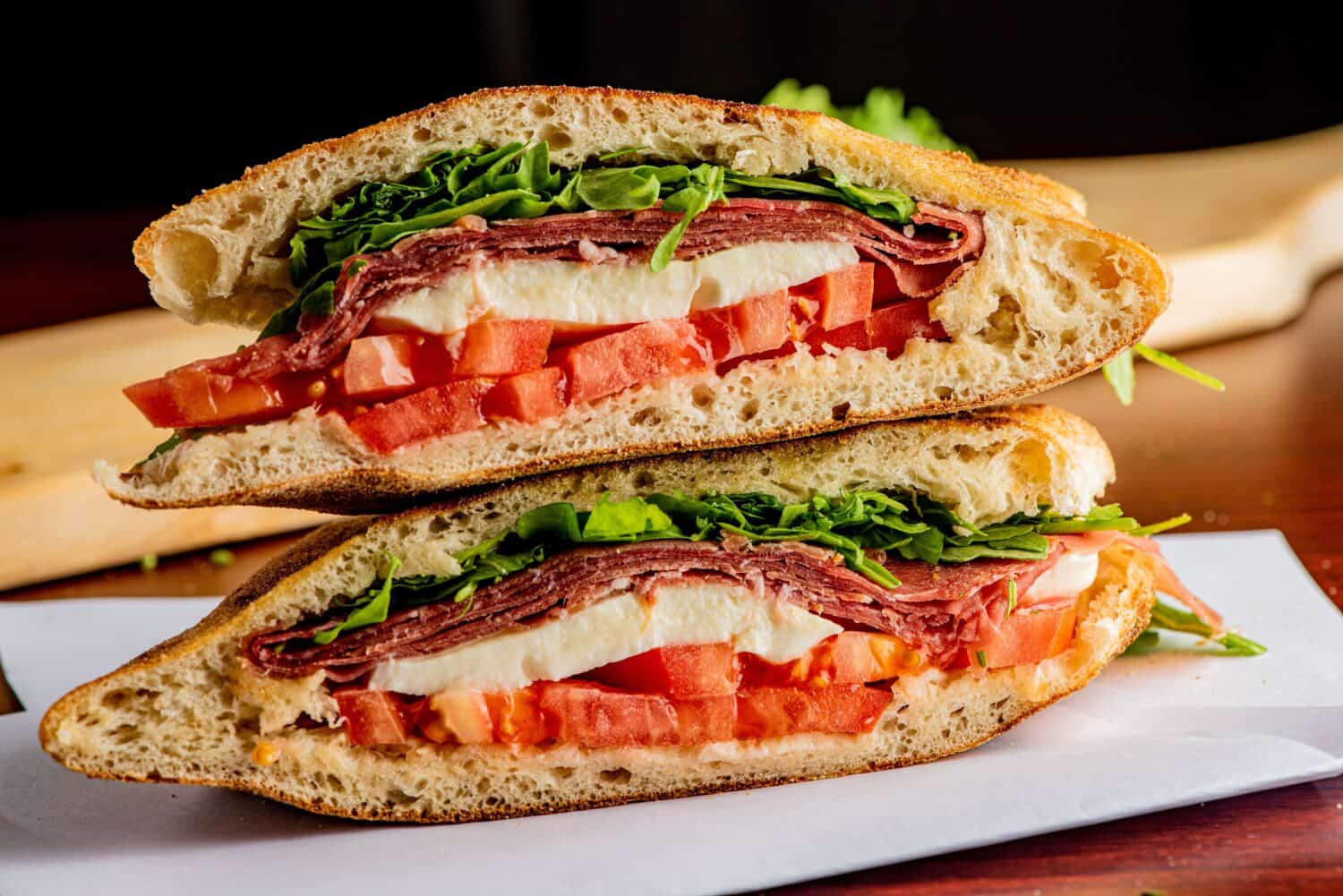
Italian Bread makes incredible sandwiches due to its thicker crust and moist, chewy interior.
©Marie Sonmez Photography/Shutterstock.com
Dipping into Soups or Sauces
French bread's crusty exterior and fluffy interior make it a classic choice for dipping into soups, stews, or sauces. Italian bread, with its heartier texture, can handle more substantial dips, like olive oil and balsamic vinegar or marinara sauce.
Specific Traditional Recipes
Certain recipes, like Croque Monsieur (a French grilled ham and cheese sandwich) or Panzanella (a Tuscan bread salad), call for specific respective bread types to achieve an authentic taste.
Substitution Options: What Can You Substitute for French or Italian Bread?
If you find yourself without French bread or Italian bread, fear not! There are several delicious alternatives to consider:
French Bread Substitutes:
- Baguettes: French bread comes in various shapes, and baguettes are the most recognizable. Look for baguettes at your local bakery or grocery store for an authentic experience.
- Ciabatta: While Italian in origin, ciabatta's airy texture and rustic crust make it a suitable substitute for French bread, as long as you're mindful of the textural differences.
Italian Bread Substitutes:
- Focaccia: This Italian flatbread boasts a fluffy interior, a crisp exterior, and is fantastic with herbs or olives. It works well as a sandwich bread or for tearing and dipping.
- Rustic Loaves: Look for artisanal breads with thick crusts and dense interiors reminiscent of Italian bread. These are especially good when you slice them for toast or for use in custardy baked dishes like Baked French Toast Casserole.
What Are Some Traditional French Bread Varieties?
French bread comes in various delightful varieties, each with its own unique characteristics and regional influences. Everyone knows and loves the baguette, but you should be aware of several other important and iconic French bread varieties in case they're your only options on the day.
Baguette:
- The quintessential French bread. You identify it in the bakery case by its iconic long and slender shape.
- It features a crisp golden crust with a soft and chewy interior.
- Baguettes are versatile and commonly used for sandwiches, as a side for soups, or enjoyed on their own.
Pain de Campagne:
- Translated as “country bread,” this rustic loaf is typically made with a mix of wheat flour, including white and whole wheat.
- Pain de Campagne has a hearty texture, slightly denser than a baguette, with a thick crust and a nutty flavor.
- It pairs well with cheeses, spreads or as a base for tartines (open-faced sandwiches).
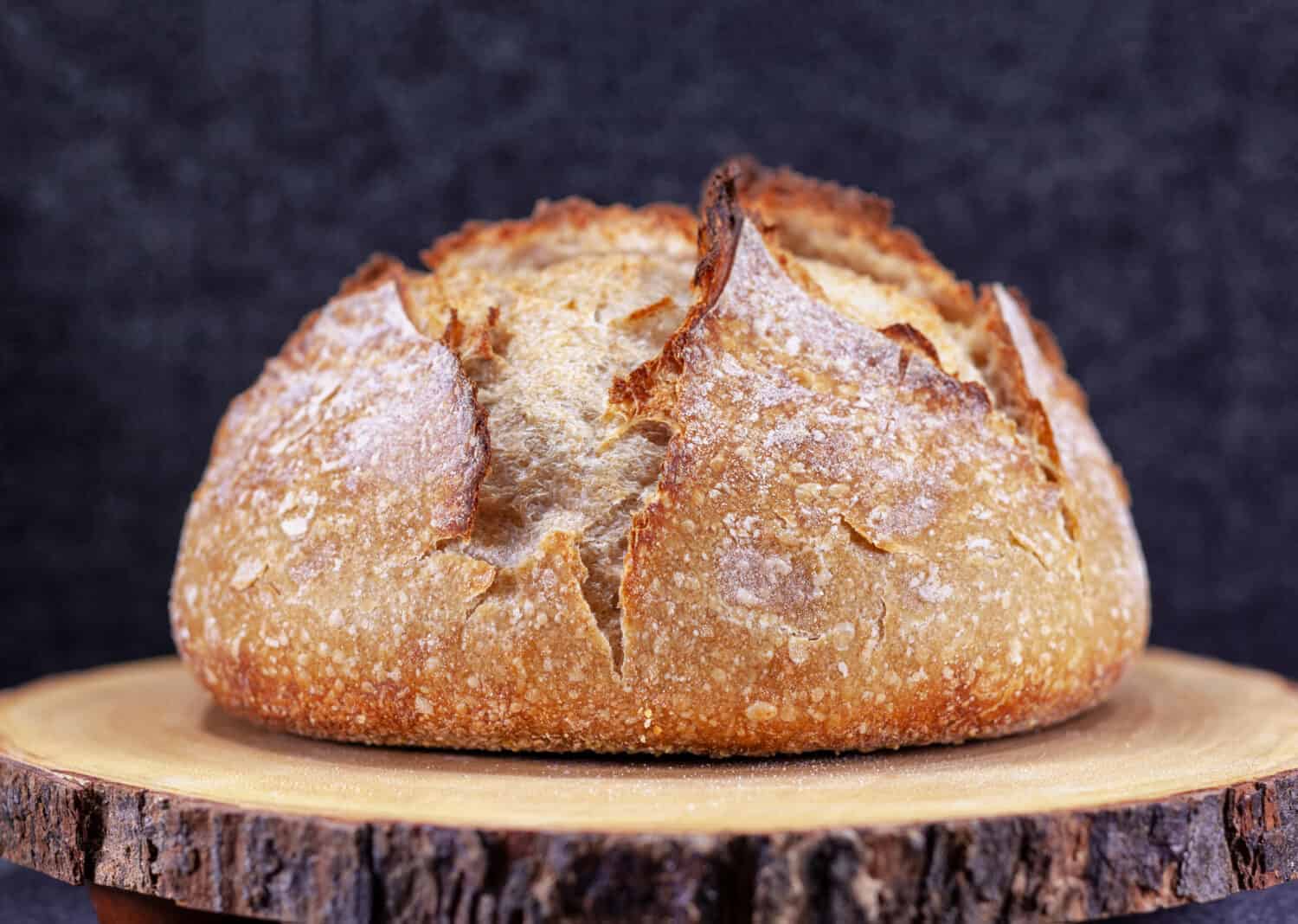
The boule is a French bread shape that is popular when making Pain de Campagne.
©Tercer Ojo Photography/Shutterstock.com
Ficelle:
- Ficelle means “string” in French, and this bread is similar to a baguette but smaller in size.
- It retains the classic baton shape and crusty exterior of a baguette but is thinner and lighter.
- Ficelles are perfect for appetizers, as accompaniments to cheese platters, or for creating delicate sandwiches.
Bâtard:
- Bâtard refers to a loaf that falls between a baguette and a wider, fuller-sized bread.
- It has a slightly shorter length than a baguette but maintains a similar crusty exterior and soft interior.
- Bâtards work well for larger sandwiches or as a centerpiece for a bread basket.
Pain de Mie:
- This French bread is often referred to as a “Pullman loaf” or “sandwich bread” due to its long, rectangular loaf shape and uniform slices. Pro tip: Ask the bakery staff to slice it for you on their machine. You won't regret it.
- Pain de Mie has a soft, tender crumb and a thin, light crust.
- It's commonly used for toast, sandwiches, and even for making French toast.
Fougasse:
- Fougasse is a flatbread with a distinct leaf-like or ear shape resembling a wheat stalk.
- It can be e with various ingredients such as olives, herbs, cheese, or even sweet additions like chocolate.
- Fougasse is perfect for tearing and sharing, serving as an appetizer or as a delightful accompaniment to soups and salads.
Pains au Levain:
- You make Levain bread with a sourdough starter, giving it a tangy flavor and a much denser crumb.
- Pains au Levain can come in various shapes and sizes, from round boules to elongated loaves.
- Everyone loves this bread for its robust flavor and because it pairs well with rich cheeses or hearty stews.
Whatever your carby needs are, there's a French bread that gets the job done.
What Are Some Traditional Italian Bread Varieties?
Italian bread, like French bread, boasts a wide variety of regional specialties that reflect the country's culinary diversity. Italians take their bread just as seriously as they take their wine and cheese and easily as seriously as their French neighbors do. Let's explore some of the most beloved types of Italian bread:
Ciabatta:
- This rustic bread, with its irregular shape and characteristic open crumb, hails from the region of Lombardy.
- Ciabatta has a thin, crispy crust and a soft, chewy interior. Its name means “slipper” in Italian, referencing its shape.
- It is often used for sandwiches, paninis, or as a base for bruschetta.
Focaccia:
- Focaccia is a flatbread that originates in Liguria but that people love and enjoy throughout Italy.
- It has a thick, pillowy texture and a signature dimpled surface. It is best when you top it with olive oil, herbs, sea salt, or other ingredients like olives or onions.
- Focaccia is versatile and can be enjoyed on its own, used as a sandwich bread, or served as an accompaniment to soups and stews. It's excellent cut into small strips and served warm with seasoned olive oil for dipping.
Pane Siciliano:
- Pane Siciliano is a traditional bread from Sicily, shaped like a twisted oval or double spiral.
- It has a golden, crusty exterior and a soft, airy interior. The twisted shape provides a delightful visual appeal.
- You can serve Pane Siciliano with antipasti, other pasta dishes, or use it to make sandwiches.
Grissini:
- Grissini, or breadsticks, are slender and crispy bread snacks that originated in the region of Piedmont.
- They are fantastic when you season them with salt or flavor them with herbs like rosemary or sesame seeds.
- Grissini are phenomenal as an appetizer, with dips, or as an accompaniment to cheese and charcuterie platters.
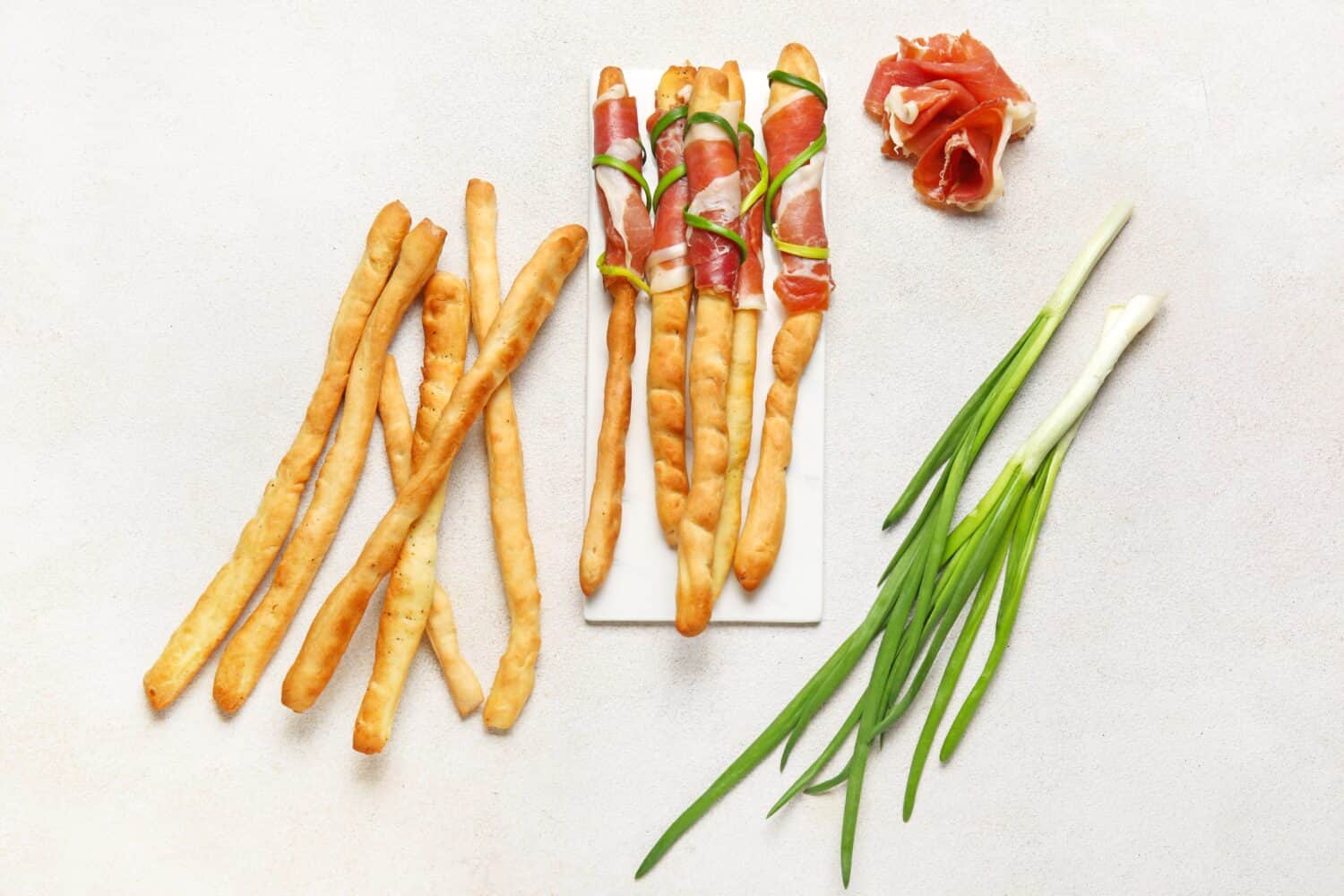
Grissini are spectacularly crisp and crunchy, not to mention golden and toasty.
©Pixel-Shot/Shutterstock.com
Pane Pugliese:
- Hailing from the region of Puglia, pane Pugliese is a hearty, round loaf with a thick, chewy crust.
- You make this variety with durum wheat flour, giving it a distinct flavor and a dense, rustic texture.
- Pane Pugliese is often enjoyed with traditional Puglian dishes, such as fava bean puree or roasted vegetables.
Pane Toscano:
- Pane Toscano, or Tuscan bread, is characterized by its crusty exterior and light, airy interior.
- Traditionally made with no salt, it has a slightly sweet taste and is often used for bruschetta or as an ingredient in Tuscan soups like ribollita.
Altamura Bread:
- Altamura bread comes from the town of Altamura in the Apulia region. It is made with durum wheat semolina and has a distinct flavor and a firm texture.
- This bread is protected by the European Union's PDO (Protected Designation of Origin) status, ensuring its authenticity.
- Altamura bread is often enjoyed with olive oil, and tomatoes or as a base for sandwiches.
These are just a few examples of the wonderful array of Italian bread varieties. Each region in Italy has its own unique bread specialties, showcasing the country's rich culinary heritage.
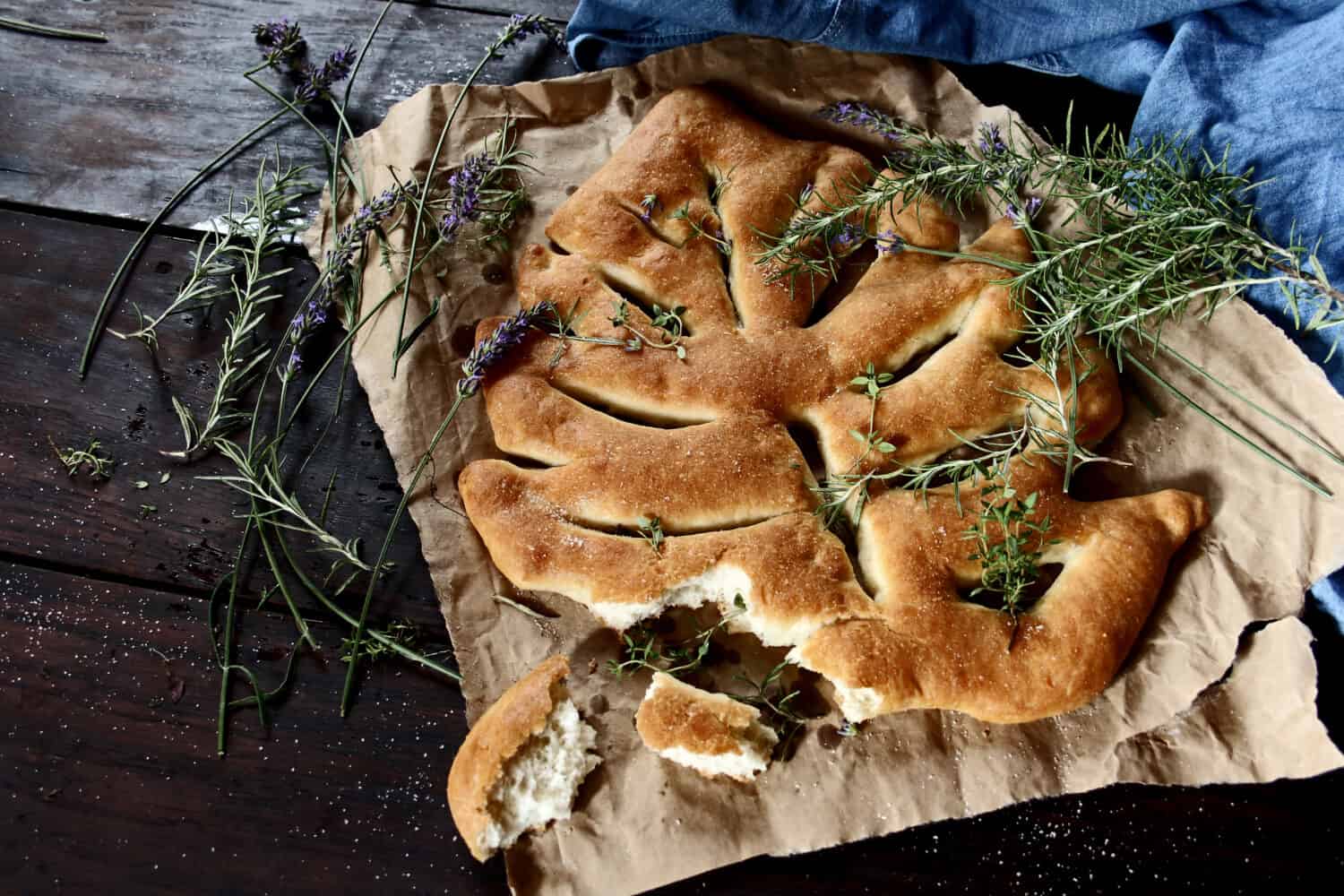
Fougasse is a famous and traditional French bread that bakers shape using cuts that turn the dough into a leaf pattern.
©melei5/Shutterstock.com
French Bread Recipes
Print
French Bread Cheeseburgers
- Yield: Makes 4 servings
Ingredients
3/4 pound lean ground beef (90% lean)
1 small onion, chopped
1 medium green pepper, chopped
2 garlic cloves, minced
2 Tablespoons all-purpose flour
2 Tablespoons Dijon mustard
1 Tablespoon ketchup
1 tube (11 ounces) refrigerated crusty French loaf
4 slices (1 oz. each) reduced fat American cheese
1 egg white, lightly beaten
3 Tablespoons shredded Parmesan cheese
Instructions
1. In a large frying pan, cook the beef, onion and pepper over medium heat until meat is no longer pink.
2. Add garlic; cook 1 minute longer. Stir in the flour, mustard and ketchup; set aside.
3. Unroll the bread dough starting at the seam.
4. Form dough into a 14×12 inch rectangle. Spoon meat mixture lengthwise down the center of the dough; top with cheese slices.
5. Bring long sides of dough to the center over filling; pinching the seam to seal.
6. Place the filled dough seam side down on a baking sheet coated with cooking spray.
7. Brush with egg white. Sprinkle with Parmesan cheese.
8. With a sharp knife, cut diagonal slits in top of loaf. Bake at 350° for 25 minutes or until golden brown.
Nutrition
- Serving Size: 1 slice
- Calories: 415
- Sodium: 975mg
- Fat: 10.5g
- Saturated Fat: 4.5g
- Carbohydrates: 43g
- Fiber: 2g
- Protein: 32g
- Cholesterol: 49mg
- Baked French Toast Casserole
- Grilled Cheese Roast Beef Sandwiches
- Classic Baguettes (King Arthur Flour)
Italian Bread Recipes
- Mozzarella Beef Sandwiches with Seasoned Broccoli
- Chicken Focaccia Sandwiches
- Easy Small-Batch Ciabatta Rolls (Ahead of Thyme)
- Best, Easiest Focaccia Bread Recipe (Alexandra's Kitchen)
Make sure you're using the right flour when it comes time to make either of these types of bread.
Conclusion
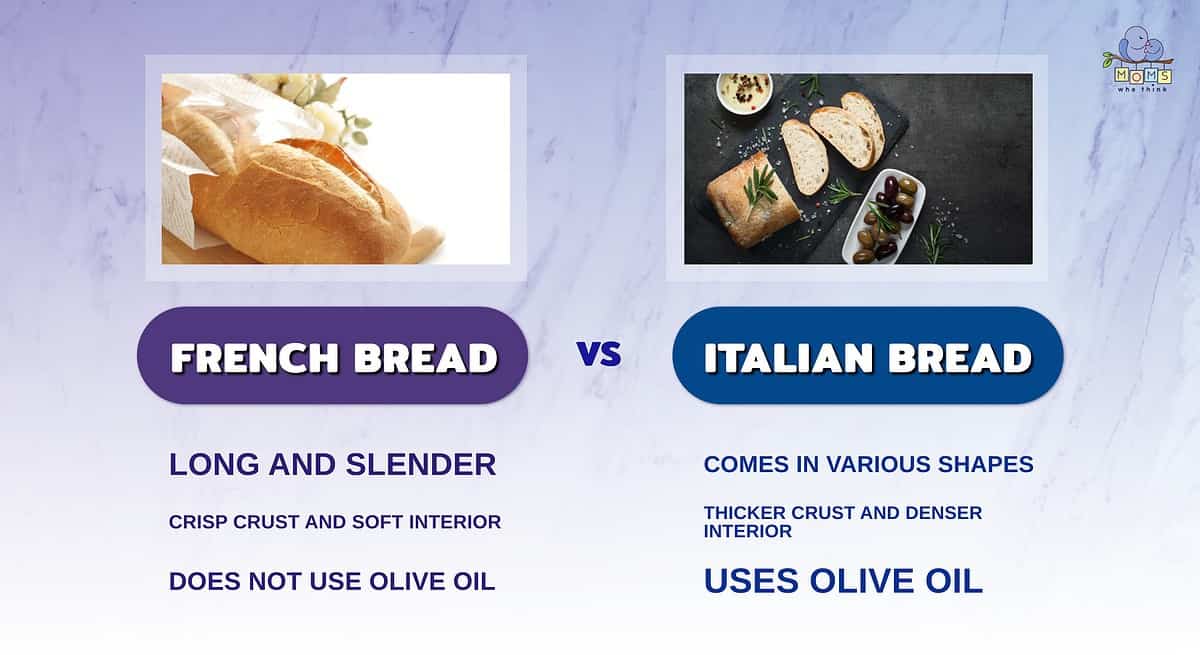
- French bread is typically long and slender, while Italian bread can come in all sorts of shapes and sizes.
- Italian bread has a thicker crust and denser interior, while French bread has a crisp crust and soft interior. Which you prefer is up to your individual preference and what you intend to use the bread for.
- One of the final major differences between these two types of bread is in their ingredients list: Italian bread uses olive oil, while French bread does not. The use of olive oil in Italian bread gives it a longer shelf life.
And that's everything you need to know about the differences between French bread and Italian bread! Remember, if one type is unavailable, don't be afraid to explore alternative options from the bakery case. Happy baking and bon appétit (or, should we say, buon appetito)!
